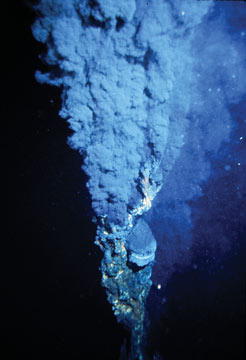|
NEWS NOTES
Plumbing the deep
 Photo by the Woods Hole Oceanographic Institution |
| A type of hydrothermal vent called a “Black Smoker” sends a cloud of hot, mineral-filled water into the ocean. Seismic data are yielding a clearer picture of the inner workings of such vents. |
Spanning more than 60,000 kilometers, Earth’s string of mid-ocean ridges form the world’s longest mountain chain. Beneath these mountains lie complex plumbing systems. Cold seawater sinks into the crust through cracks and fissures, picks up heat and nutrients belowground and then rises, exiting through hydrothermal vents. The outlets for this underground maze are marked by vast plumes of colored water and unusual life forms, but the entrances can be hard to spot. By tracking earthquakes, researchers may have found one such entrance and overturned a classic model of hydrothermal circulation in the process.
Most of the diagrams depicting this subterranean plumbing show the water flowing perpendicular to the ridge after entering through large faults along the ridge’s flanks to reach vents at the center of the ridge. “People just assumed that was the circulation pattern,” says Andy Fisher, a hydrogeologist at the University of California at Santa Cruz. New seismic and temperature readings, however, suggest that — at least in one spot — the water actually enters the crust at the ridge’s center and flows parallel to the ridge. The distinction may not seem important, but it is, Fisher says. “These vent systems may have been where life originated on Earth. We need to understand how they work.”
Models suggest that when the cold seawater that fuels hydrothermal vents enters the magma-warmed crust, cracking occurs, triggering mini-earthquakes. These earthquakes could theoretically be used to help researchers map out where recharge is occurring. To test that idea, Maya Tolstoy and her colleagues at Columbia University’s Lamont-Doherty Earth Observatory in New York placed seven seismometers on the East Pacific Rise about 900 kilometers southwest of Acapulco, a volcanic region containing hydrothermal vents with names like “Hole to Hell.”
Over the course of seven months, the seismometers picked up more than 7,000 tiny earthquakes. These quakes cluster neatly, outlining a duct that plunges 700 meters into the crust, and then turns horizontally and widens to 200 meters. But instead of running perpendicular to the ridge, the earthquakes follow the ridge, bottoming out at 1.5 kilometers below the seafloor, just above the ridge’s magma chamber. There the water warms and the crust stops cracking.
This seismicity represents a zone where cold water flowing belowground is causing hydrothermal cracking, Tolstoy and her colleagues wrote in Nature on Jan. 10. At the spot where Tolstoy and her colleagues found the shallowest earthquakes, the ridge forms a kink that may be allowing water to enter the crust. Tolstoy compares the kink to a chip in a car windshield. “It’s constantly under stress; it’s constantly cracking,” she says.
Tolstoy’s team has non-seismic evidence as well. Scientists began recording the temperatures of the vents in the early 1990s, after a large volcanic eruption. All the vents started off at about the same temperature, Tolstoy says, but over time a gradient emerged. “The vent closest to the kink gradually cooled down,” she says. “By 2003 it had died altogether.” Vents farther from the kink, however, cooled only slightly, while those farthest away stayed hot or got hotter. This indicates that the kink may have only recently become a point where cool seawater enters the subsurface.
The Columbia team is not the first to suggest that water may be flowing parallel to ridges instead of perpendicular to them. Scientists have debated the topic since the late 1970s. But neither side possessed much evidence.
Fisher says the Columbia team’s argument is convincing. “It’s not proof positive,” he says. “But each observation adds a little bit of weight to the story.” He points out, however, that seismic activity is only a proxy for the water’s movement. Tolstoy and her colleagues hope to eventually address that problem by using dye to directly track the water and to see where it’s going and how long it spends underground. Finding dyes or other tracers that can withstand the high temperatures found near a magma chamber, however, has been a challenge.
But even if she and her colleagues could definitively prove that water is flowing parallel to this ridge, other ridges — or other parts of the same ridge — may not work the same way. In fact, in some parts of the ocean, water might be flowing just as it’s depicted in the classic diagrams. “We can’t rule that out,” Tolstoy says, “but we do not see any evidence for it.”

 Subscribe
Subscribe


